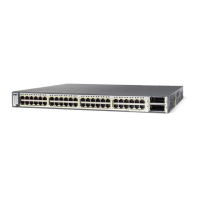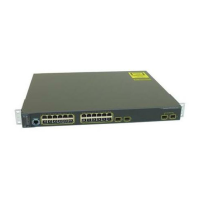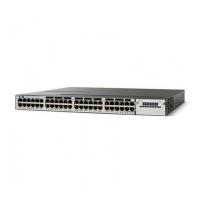42-78
Catalyst 3750-X and 3560-X Switch Software Configuration Guide
OL-21521-01
Chapter 42 Configuring IP Unicast Routing
Configuring Multi-VRF CE
• A customer can use multiple VLANs as long as they do not overlap with those of other customers.
A customer’s VLANs are mapped to a specific routing table ID that is used to identify the
appropriate routing tables stored on the switch.
• The switch supports one global network and up to 26 VRFs.
• Most routing protocols (BGP, OSPF, RIP, and static routing) can be used between the CE and the
PE. However, we recommend using external BGP (EBGP) for these reasons:
–
BGP does not require multiple algorithms to communicate with multiple CEs.
–
BGP is designed for passing routing information between systems run by different
administrations.
–
BGP makes it easy to pass attributes of the routes to the CE.
• Multi-VRF CE does not affect the packet switching rate.
• VPN multicast is not supported.
• You can configure 104 policies whether or not VRFs are configured on the switch or switch stack.
• You can enable VRF on a private VLAN, and the reverse.
• You cannot enable VRF when policy-based routing (PBR) is enabled on an interface, and the
reverse.
• You cannot enable VRF when Web Cache Communication Protocol (WCCP) is enabled on an
interface, and the reverse.
Configuring VRFs
Beginning in privileged EXEC mode, follow these steps to configure one or more VRFs. For complete
syntax and usage information for the commands, see the switch command reference for this release and
the Cisco IOS Switching Services Command Reference, Release 12.2.
Command Purpose
Step 1
configure terminal Enter global configuration mode.
Step 2
ip routing Enable IP routing.
Step 3
ip vrf vrf-name Name the VRF, and enter VRF configuration mode.
Step 4
rd route-distinguisher Create a VRF table by specifying a route distinguisher. Enter either an
AS number and an arbitrary number (xxx:y) or an IP address and
arbitrary number (A.B.C.D:y)
Step 5
route-target {export | import | both}
route-target-ext-community
Create a list of import, export, or import and export route target
communities for the specified VRF. Enter either an AS system number
and an arbitrary number (xxx:y) or an IP address and an arbitrary
number (A.B.C.D:y). The route-target-ext-community should be the
same as the route-distinguisher entered in Step 4.
Step 6
import map route-map (Optional) Associate a route map with the VRF.
Step 7
interface interface-id Specify the Layer 3 interface to be associated with the VRF, and enter
interface configuration mode. The interface can be a routed port or SVI.
Step 8
ip vrf forwarding vrf-name Associate the VRF with the Layer 3 interface.
Step 9
end Return to privileged EXEC mode.
